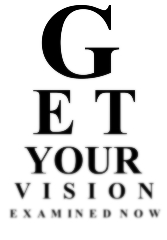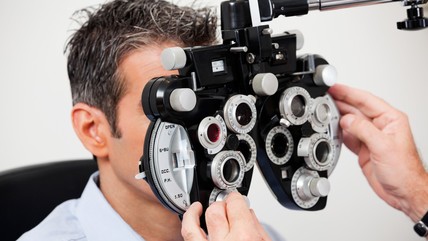eye carE information
|
Annual Vision Exams
The importance of an annual eye exam.
The most common vision problems are focusing problems, often called refractive errors. Fortunately, these conditions can be corrected with eyeglasses, contact lenses or laser vision correction. When you begin to notice a problem with your vision, it's time for an eye exam to find out if you need a new prescription for corrective eyewear. Even when you're not experiencing problems, regular eye exams can prevent serious eye conditions that sometimes give us little or no clues at all.
Evaluation of the ocular effects of diabetes, high blood pressure, thyroid disease, cataracts, glaucoma and conditions involving the retina (the back of the eye) are just a few of the problems that can be detected. That's why an annual visit to Redfield Vision should be an important part of your annual health care plan. |
During your eye exam, Dr. Redfield checks how well your eyes work together and alone with your brain to create images of the world around you - colors, light, shapes and sizes. You will be asked questions about your health history, your family's medical history, instances of eye problems in the past, and your work and lifestyle habits.
Why children need eye exams
Studies have determined that 88% of learning is visual. When you consider that one in four children ages 5 to 12 has an undiagnosed vision problem, you'll understand why educational performance is likely to be affected by poor vision. Unfortunately, children with vision problems often have no way of knowing that they see differently than other children. It is the responsibility of the parents to help children reach their potential by making sure they are free of vision problems.
Amblyopia, also called "lazy eye", often develops in young children and is characterized by unclear vision. Left undetected, amblyopia can cause a lifetime of visual disability that is not correctable by glasses or contact lenses.
Amblyopia, also called "lazy eye", often develops in young children and is characterized by unclear vision. Left undetected, amblyopia can cause a lifetime of visual disability that is not correctable by glasses or contact lenses.
Common vision problems
Every vision problem, no matter how common, is an important concern for Dr. Redfield because good vision is important for everyone. Complete eye exams can reveal serious and sometimes hidden eye problems. Here is a description of conditions that are often diagnosed and treated at Redfield Vision:
A cataract is simply a clouding of your eye's natural lens and often affects both eyes. A cataract may cause hazy, blurred or sometimes double vision, in addition to sensitivity to light and glare and frequent eyeglass prescription changes. Cataracts may develop gradually over many years or progress rapidly.
Dr. Redfield diagnoses cataracts with a thorough eye examination, which determines the density and location of the cataract. When cataracts begin to interfere with your normal activities, Dr. Redfield will refer you to a cataract surgeon for an outpatient procedure, which removes the clouded lens and replaces it with a permanently implanted intraocular lens.
Glaucoma is often called "the silent threat". It is a slow, progressive loss of peripheral or side vision. Only a thorough eye examination can determine if you have glaucoma. It important to remember that control of glaucoma usually involves having Dr. Redfield regularly check your eye pressure and perform a diagnostic test called a visual field.
Macular degeneration occurs when the eye's macula - the center of the retina where the best vision is located - may be degenerating. Blood vessels can grow abnormally underneath the retina. Blood and other fluids leak out, causing the layers of the retina to separate. A patient with macular degeneration sees a dark blur in the center of their view. Often, straight lines look wavy, or color vision is dim.
Macular degeneration occurs when the eye's macula - the center of the retina where the best vision is located - may be degenerating. Blood vessels can grow abnormally underneath the retina. Blood and other fluids leak out, causing the layers of the retina to separate. A patient with macular degeneration sees a dark blur in the center of their view. Often, straight lines look wavy, or color vision is dim.
This condition often occurs in people over 60. In the final stages of macular degeneration, patients have a large hole in the center of their vision, which prevents them from being able to read, watch TV, drive safely or recognize faces. While damage that has occurred cannot be reversed, slowing down or arresting progress of the disease is possible. Early diagnosis requires a complete eye exam and special testing procedures.
Strabismus is a misalignment of the eye, which causes them to point in different directions. One eye may be directed straight ahead while the other eye is turned inward, outward, upward or downward. Strabismus can be treated at any age. Treatment typically consists of prescription lenses and a program of vision therapy. Surgery may cosmetically straighten the eyes, but does not typically improve vision. It is a misconception to believe that strabismus will go away by itself or that the child will outgrow it.

